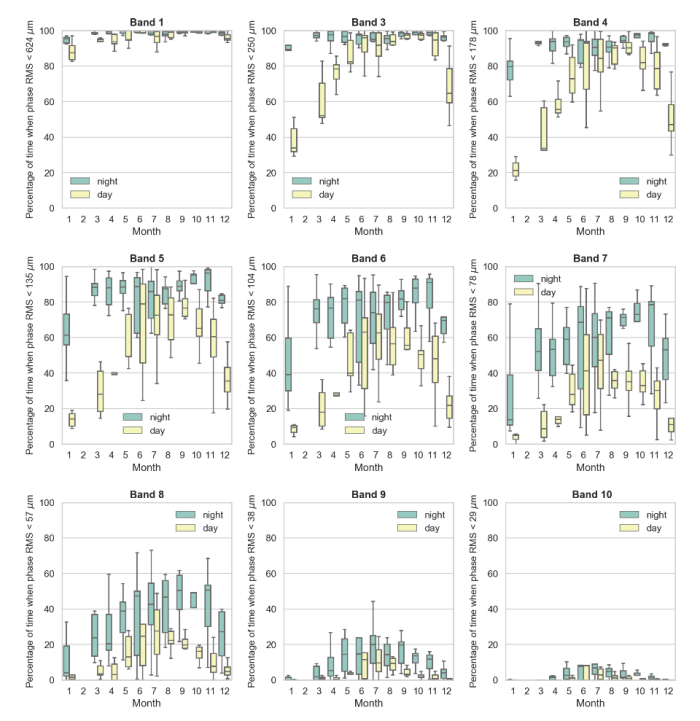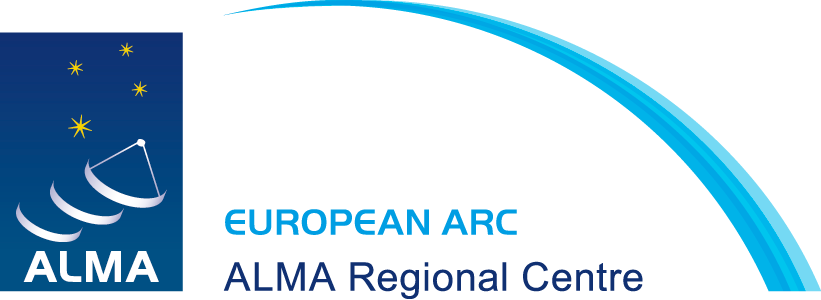The newly published ALMA memo 624 (https://library.nrao.edu/public/memos/alma/main/memo624.pdf) is a re-visit to ALMA site properties and the successor to the Evans 2003 site stringency work (ALMA memo 471 that used only a 300m baseline phase monitor). Importantly, the phase RMS is the main focus of the new memo, and is measured using ALMA data since Cycle 3 (over 17000 Executions blocks). Using the bright bandpass sources, the phase RMS can be measured over various timescales (30s to 240s) and at all baseline lengths observed. Scaling trends are also used to extrapolate short baseline phase RMS (from short baseline configurations) to longer baseline values as to provide a comparable sample for 'summary' baseline lengths of 500, 1000, 5000 and 10000m in all EBs.
ALMA memo 624 - Updates to ALMA site properties: using the ESO-Allegro Phase RMS database

Percentage of time available when phase RMS is <30deg (per band shown in microns path length) at a 5000m baseline over a 60s timescale for night and day (7am to 7pm CLT). The central horizontal line in the boxes are the median values, the edges are the 25th and 75th percentiles and the whiskers are the min and max. Data from Cycle 3 (2015) to Cycle 7 (2021) are used.
The memo reports the variations of phase RMS over the year, i.e per-month, and concludes that it is worse in Chilean summer (December, January, February) but notably better in Chilean winter (June, July, August). There are also significant diurnal variations where phase RMS in summer can be over seven times worse at the peak of day as compared to night time, while in winter the change over 24h is typically less than a factor of three. The take-away message here is that winter and night time are the best possible times to achieve a low phase RMS (i.e. stable atmospheric conditions) for High Frequency and/or long baseline observations. The memo also shows how the vast majority of observations are improved by the WVR system, although for higher frequency bands (Bands 8, 9 and 10) the typical improvement is a factor of 1.1 to 1.3.
The memo addresses cases for High-frequency and (with) long baseline observations. Using the summary baseline phase RMS values it is possible to estimate the percentages of time available (based on when ALMA can observe) when observing in a particular configuration and using a specific calibration timescale (observing scheme, i.e. depending on the calibration cycle time used) for a given phase RMS limit. The figure shows the percentage of time available (in night and day - where day is simply 7am to 7pm CLT) for a 'summary' 5000m baseline (representative of a C-7 configuration) when using a 60s timescale (similar to the long-baseline phase referencing observing scheme). The phase RMS limit for each band is shown in microns of path length variation and ties to 30deg Phase RMS (stable conditions). It is clear that at the lower frequencies (Bands 1 to 6) one could conduct observations over 80% of the time at night, while this is reduced during the day (and with increasing frequency band). From Band 7, and specifically at Bands 9 and 10, the Chilean winter nights are the best time to observe with up to ~40% of the time available for Band 8 and 20% for Band 9 (on the 5000m baseline length).
Current and future work using the phase RMS database will help to optimise the cycle time and observing processes at ALMA.

